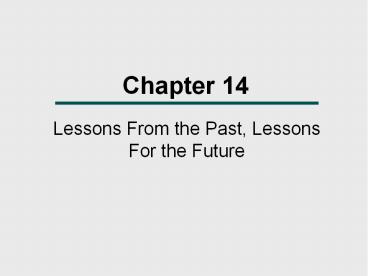Lessons From the Past, Lessons For the Future - PowerPoint PPT Presentation
1 / 24
Title:
Lessons From the Past, Lessons For the Future
Description:
Chapter 14 Lessons From the Past, Lessons For the Future Chapter Outline How Successful Are We? Humans and the Impact of Culture The Loss of Biodiversity The Present ... – PowerPoint PPT presentation
Number of Views:50
Avg rating:3.0/5.0
Title: Lessons From the Past, Lessons For the Future
1
Chapter 14
- Lessons From the Past, Lessons For the Future
2
Chapter Outline
- How Successful Are We?
- Humans and the Impact of Culture
- The Loss of Biodiversity
- The Present Crisis Our Cultural Heritage?
3
Neolithic
- The period during which humans began to
domesticate plants and animals. - The Neolithic is also associated with increased
sedentism. - Dates for the Neolithic vary from region to
region, depending on when domestication occurred.
4
Mesolithic
- The period preceding the Neolithic, during which
humans increasingly exploited smaller animals
(including fish), increased the variety of tools
they used, and became somewhat less nomadic.
5
Map of Deforestation
6
The Loss of Biodiversity
- Biodiversity is the totality of all living
things, from bacteria and fungi to trees and
humans. - We are currently losing biodiversity, but we
dont know the exact rate of loss or what its
impact will be. - The geological record indicates that in the past
570 million years, there have been at least 15
mass extinction events, two of which altered all
of the earths ecosystems.
7
Mass Extinction Events
- The first occurred 250 million years ago and
resulted from climatic change following the
joining of all the earths landmasses into one
supercontinent. - The second event happened 65 million years ago
and ended 150 million years of evolutionary
processes that produced the dinosaurs. - This is believed to be the result of climate
changes following the impact of an asteroid.
8
Mass Extinction Events
- A third major extinction event is occurring now,
and may have begun in the late Pleistocene or
early Holocene - Many scientists believe several large mammalian
species were pushed toward extinction by humans,
near the end of the Pleistocene, some 10,000
years ago. - In North America, at least 57 mammalian species
became extinct, including the mammoth, mastodon,
giant ground sloth, saber-toothed cat, several
large rodents, and numerous grazing animals.
9
Overpopulation
- Scientists estimate that around 10,000 years ago,
only about 5 million people inhabited the earth. - By A.D. 1650, there were perhaps 500 million, and
by 1800, 1 billion. - Between 10,000 years ago and A.D. 1650 population
size doubled 71 times.
10
Overpopulation
- Dates and associated population estimates up to
the present are as follows - mid-1800s, 1 billion
- 1930s, 2 billion
- mid-1960s, 3 billion
- mid-1980s, 4 billion
- present, 6 billion
11
Line Graph Depicting Exponential Growth of Human
Population
12
The Greenhouse Effect And Global Warming
- Activities involved in the production of goods
and services produce waste and pollution, all of
which leads to environmental degradation. - Much of the energy used for human activities is
derived from burning of fossil fuels. - Burning fossil fuels releases carbon dioxide into
the atmosphere, and this, in turn, traps heat.
13
Deforestation
- Deforestation contributes to global warming,
since were reducing the number of trees
available to absorb carbon dioxide. - In the tropics, trees are burned as land is
cleared, a practice that releases yet more carbon
dioxide. - An estimated 20 of all carbon dioxide emissions
are accounted for by the burning of the Amazon
rain forest alone.
14
Climate Change
- Since records began being kept in 1860, the 1990s
were the hottest decade, followed closely by the
1980s. - The year 2002 had the distinction of being the
warmest year on record, with 1998 running a close
second. - The summer of 2003 was the hottest on record in
Europe, and for the first time in recorded
history, the temperature reached 100F in London.
15
Climate Change
- According to the U.N. Intergovernmental Panel on
Climate Change, the average surface temperature
of the earth increased by 0.8 C between 1961 and
1990. - An increase in the mean annual temperature
worldwide of 0.51C could result in melting of
the polar caps and flooding of coastal areas. - Experts believe Greenlands ice sheet will
disappear if temperatures increase 3.0C. - This could raise sea levels by as much as 23 feet
over the next 1000 years.
16
Quick Quiz
17
- 1. The population of the world today is around
______ billion. - 2
- 4
- 6
- 10
18
Answer c
- The population of the world today is around 6
billion.
19
- 2. The adaptive strategy of humans has always
been - fight or flight.
- culture.
- aggression.
- expansion.
20
Answer b
- The adaptive strategy of humans has always been
culture.
21
- 3. In the past 570 million years, there have been
______ mass extinctions. - 4
- 10
- 15
- 21
22
Answer c
- In the past 570 million years, there have been 15
mass extinctions.
23
- 4. The problem that is linked to all other life
forms and is therefore the most important problem
facing human beings is - population increase.
- competition for resources.
- polluted air.
- loss of biodiversity.
24
Answer a
- The problem that is linked to all other life
forms and is therefore the most important problem
facing human beings is population increase.





























![[PDF READ ONLINE] 21 Lessons for the 21st Century PowerPoint PPT Presentation](https://s3.amazonaws.com/images.powershow.com/10106291.th0.jpg?_=20240823111)

